Media | Articles
5 famous V-8s whose displacements stretched the truth
We know that the 1960s were full of horsepower hijinks, but did you know that manufacturers sometimes fibbed about the size of their engines? Indeed, that burbling V-8 in your beloved classic may actually not measure up to its promised displacement. We rooted out five of the worst offenders.
Ford/Mercury 427

Available from mid-1963 to mid-1968, the 427 was Ford’s crowning achievement in the 1960s, carrying the torch during Ford’s “Total Performance” reign of global competition. However, to American enthusiasts, the 427 is best known for powering Fords and Mercurys to success on the drag strip and in NASCAR. The FE-series engine was introduced at the same time as Ford’s semi-fastback roofline for the Galaxie 500 and Galaxie 500/XL (as well as Mercury’s Marauder sub-series), and the silhouette’s aerodynamic advantages helped maximize the engine’s performance on the banked ovals. The street 427 was available with either a single or pair of four-barrel carburetors for 410 or 425 horsepower, respectively. Several thousand 427s were built through 1964, with popularity falling drastically in 1965, the last year of big Mercury; in its swan-song year of 1967, the 427 was installed in 89 full-size Fords.
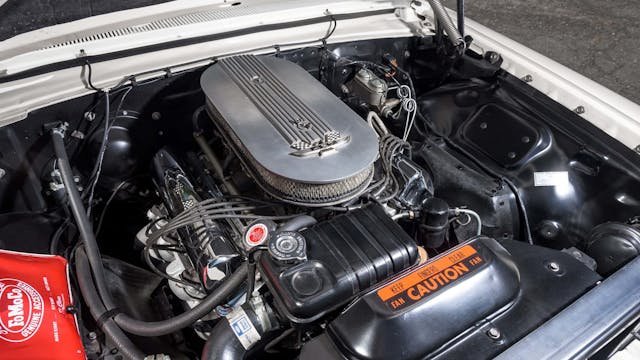
Even with pressure from the GTO and Chrysler’s Hemi, Ford produced only 57 1966 Fairlane 500 hardtops carrying the 427, which were joined by a nominal 229 Fairlanes and 60 Comets and Cyclones in 1967. The very last 427 produced was the 1968 Cougar GT-E (detuned with hydraulic lifters and a four-barrel for 390 hp); after the ’68 model year, it was replaced by the 428 Cobra Jet.
The 427’s bore and stroke was 4.232 x 3.784 inches. Plug that into your engine-displacement calculator and you’ll get 425.816 cubic inches. Since Chrysler already had a 426, did Ford want to advertise a superior size?
Pontiac 428
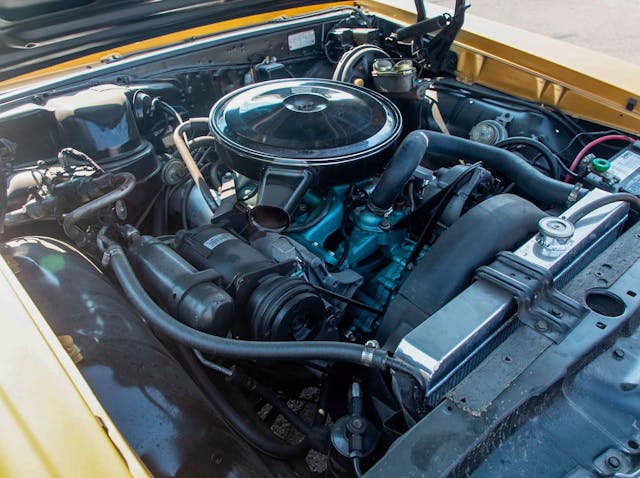
As far as the bigger Pontiac engines are concerned, the 428 is somewhat lost between the 421 from Pontiac’s racing heyday and the massive 455. However, from 1967–69, the 428 was the top engine for Pontiac’s full-size series. Initial power output was 360 hp or, in High Output (HO) configuration, 376. For 1968, those ratings were bumped to 375 and 390 hp, respectively. For 1969 a lesser, 360-horse version became standard for the Bonneville, though HO was still optional for all full-size Pontiacs. The 428 also was available for the downsized 1969 Grand Prix, with a 370-horse iteration standard with the SJ package and the HO optional for both the J and SJ. The latter made for a personal-luxury car that was faster than some GTOs.
Marketplace
Buy and sell classics with confidence
Alas, the 428 wasn’t quite what it seemed. When you account for the 4.12-inch bore and 4.0-inch stroke, actual displacement comes out to 426.613 cubic inches.
Ford/Mercury 428

A member of the FE engine series like the 427, the 428 debuted for the 1966 model year. Unlike the 427, the 428 was designed to deliver smooth, streetable power—it was rated at 345 hp. Though available for all full-size Ford and Mercury models, it was showcased in the Galaxie 7-Litre and S-55. The 428 continued to be available through 1968, though it was available through 1970 in 360-horse Police Interceptor form. The 1967–68 Shelby GT500 also used the PI 428.
Of course, the 428 is most famous for the Cobra Jet variant that debuted at the 1968 Winternationals and hit the streets in April of that year. It was rated at 335 horsepower but was actually was more powerful than both the regular and the PI 428. Though available for FoMoCo’s pony cars and mid-sizers in 1968, the 428 Cobra Jet was discontinued for mid-size cars in 1970 and pony cars in ’71.
The 428’s bore and stroke measured 4.132 x 3.984 inches, which equals 427.386 cubic inches. Yes, you read that right—the 428 is a 427! Because Ford already had a 427 of sorts, the folks at Dearborn simply rounded up.
Pontiac 350

Pontiac’s 5.7 often gets lost in the shuffle, even though it was produced well into the 1970s. The 350 was Pontiac’s bread-and-butter option for mid-size vehicles and Firebirds starting in 1968 (it replaced the 326), but the High Output variant was overshadowed by the GTO and Firebird 400. The 350 HO was rated at 320 horsepower and available in the Firebird HO plus any A-body coupe, convertible, or sedan. For 1969, horsepower jumped to 325 horses for the Firebird HO and 330 for A-bodies. This was the same engine that had been planned for the stillborn Tempest-based “ET” that evolved into the GTO Judge.
Even so, a 3.875-inch bore and 3.746-inch stroke doesn’t equal 350 cubic inches. In fact, it yields 353.42.
Pontiac 326
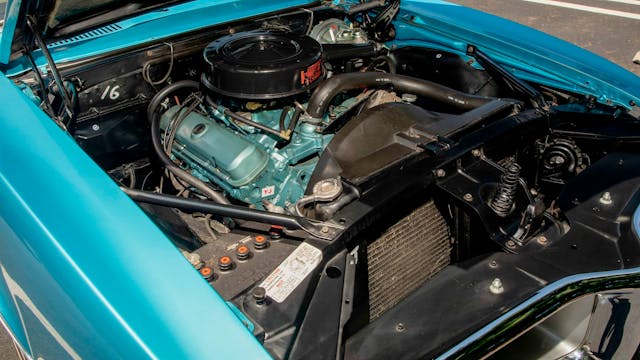
None of the above engines have the twisted history of Pontiac’s 326. First appearing in 1963, the 326 featured a bore and stroke of 3.781 x 3.746 inches, which equals 336.481 cubic inches. What gives, Pontiac?
Starting in 1955, small GMC trucks with gasoline V-8s began using Pontiac engines. For 1958, GMC took Pontiac’s 370 block and gave it a 3.875 x 3.5625 bore and stroke for a total of 336.107 cubic inches. The following year, GMC took the new 389 and recreated the 336 with new dimensions. An evolution of this engine was made an option for the 1963 Tempest series as a replacement for Buick’s aluminum 215 V-8: two-barrel variants made 250 or 260 hp, depending on compression ratio, and the four-barrel High Output version made 280. But you’ve probably heard the folklore about cubic-inch edicts at General Motors at the time; for smaller cars, that limit was 330 cubic inches. As such, Pontiac called the 336 a 326. According to Pontiac historian Don Keefe, corporate brass caught wind of the transgression and made Pontiac correct the issue. Therefore, from 1964–67, the 326 featured a 3.71875 bore for a more politically correct final displacement.
Know of any other engines that don’t live up to their advertised displacements? Tell us about them!
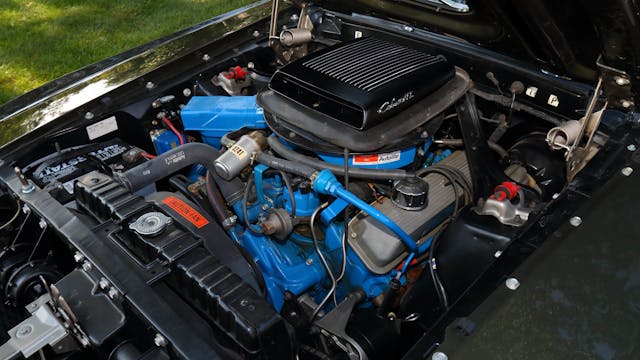




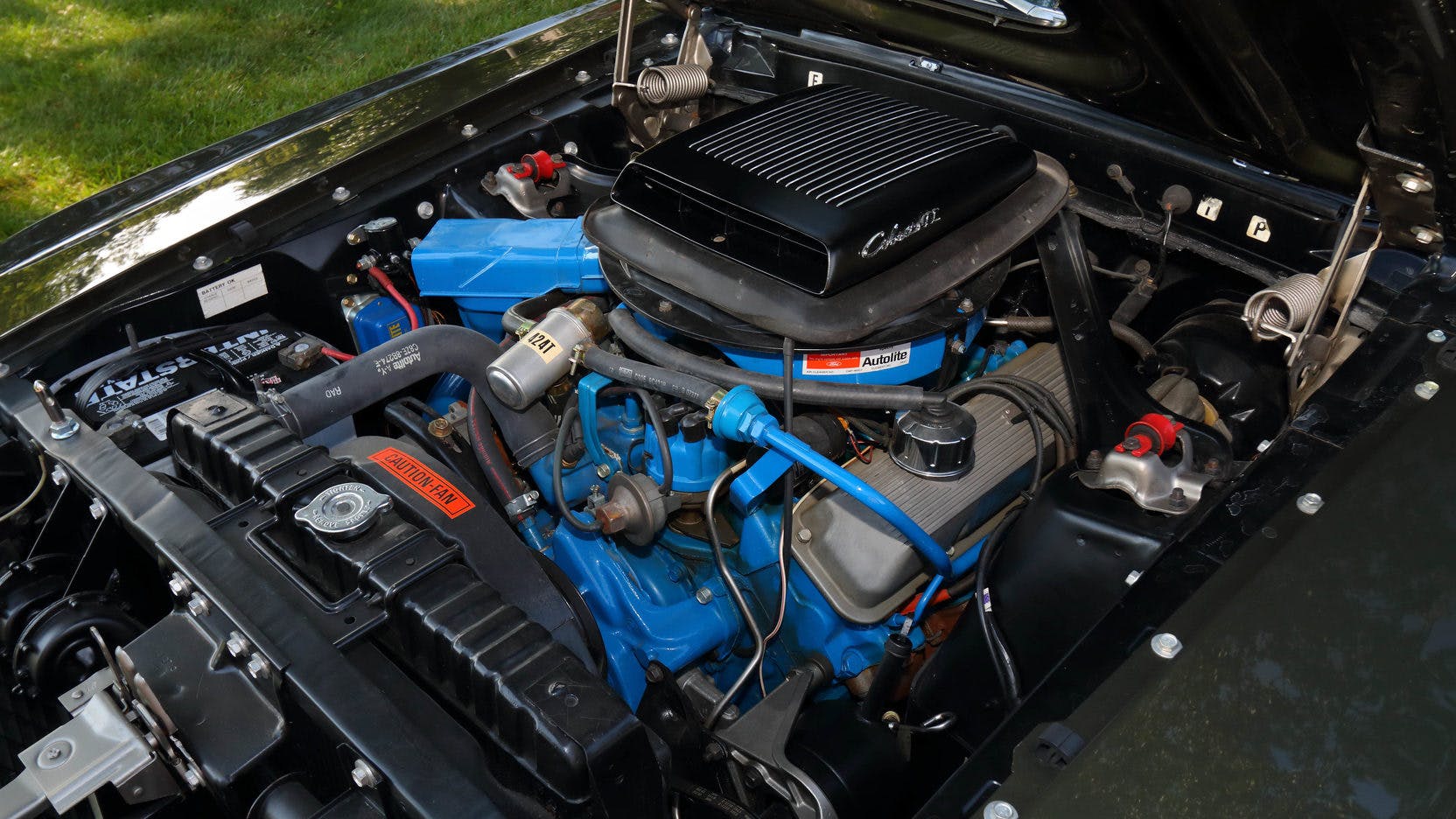
I just love the car companies’ fun with numbers. I was impressed by the brute power of the 400″+ engines.
Agreed. A friend’s 67 GTO responded incredibly well to a hydraulic high lift cam and Gratiot Auto 3angle valve job. Stock it was pbbth at 5K, new cam, carb, intake took it to 6K+ but we were afraid to go much past 6K. I wanted a 3K hole shot TC but he didn’t…
Chevrolet’s 396 (402)?
That’s the first one that I thought of.
But at least it started out as a 396.
I love my M156 AMG SL63 engine (520 HP normally aspirated.) BUT it’s actually 6.2 liters …so it seems everybody even Mercedes/AMG rounds up !
I believe the SL63 is rated at 518HP. I know my ’11 is.
This sizing optimism actually started with the previous gen AMG 55’s which were really 5.4 litres.
Typical. GM and Ford guys gotta lie about their size …. Lol
youre just mad we make more power, cheaper, and have transmissions to hold it
All are great motors. There are plenty of fibbers to be mentioned. Remember the Mustang GT 5.0 which was really a 4.9 that they rounded up?
There is a 4.9 Ford engine that came in a lot of F150’s. In the F150 you could order a 4.9(300 ci 6 cylinder) or a 5.0(302 ci v8).
This MAY be the longest running exaggeration. For how long the 302 cid was marketed as the rounded up litre, I am surprised Ford never marginally increased bore or stroke to be an “honest” 5.0
The truth is, men ALWAYS round up any measure.
This is certainly the one I remember made even more infamous when Vanilla Ice rapped about “rollin’ in my 5.0 so my hair can blow…” LOL
I knew that Ford had taken ‘CID liberties’ with the 427 and 428 big blocks….but why would Pontiac want to confuse their 353 small block with the ubiquitous Chevy 350?
Maybe the ‘corporate’ 350 V8 (Zzzzz) was already in the works…?
If you look at the engineering design papers for the Ford 427 the numbers are a bit different. The bore is 4.2346 and the stroke is 3.784 which yields a displacement of 426.34. Not quite as far off as implied. Interestingly using the upper tolerances can give you close to 427. The bore range is 42328 – 42364. 4.2346 +- .0018 and the stroke is 3.784 *- .002. Using the upper tolerances of 4.2364 x 3.786 yields 426.93. It can definitely be in the range of a 427 but it definitely couldn’t be a 426 since that was a mopar.
The 426 c.i. To this day reins King in the horsepower/torque ring….The G.M. 426 c.i. Detroit Diesel being the six banger 426..6 cylinder x 72 c.i. per cylinder has powered everything for years on end and the other one. The one that Chrysler took out a full page ad thanking G.M and Ford for running 426 Chrysler Motors in their Funny Cars with that motor still raising hell on the street and strip.
The Detroit Diesel engines in the “-71” series displaced 71 cubic inches per cylinder, not 72. The (in)famous 6-71 Detroit was loved for only two reasons: the noise it made and the ability to donate the scavenge blower to hot rodders wanting to make that cool “blower lope” sound.
If you recall a 1970 Hot Rod Magazine dyno shootout article between the 427 Chevy and the 426 Chrysler Hemi, the Chevy made more peak horsepower while the Hemi made more broad-range horsepower, i.e., power available from a lower RPM. No other ’60’s V8 made more total horsepower than the Chevy ZL-1, however.
More to the point was what NHRA factored the factory hp ratings for balance of performance (ok, way b4 that became. Thing in F1). The ZL1 was just an L88 with an aluminum block…my brothers nova ZL1 motor launched a rod and he replace it with an iron block…it was $3K IIRC just for a replacement ZL1 427.
Wrong the Ford 427 SOHC and even the 427 Tunnel Port were significantly higher as shown by there records in racing .We had two Boss 429’s back when they were cheap and when you installed a decent cam and headers (both those were in on ZL1’s ) they were monsters .We installed a SOHCin one one the Bosses and no car could compete against it .I was quite a bit younger and evolved away from straight line racing and got very involved in road racing so I lost interest in big engines .
And those engines were all select fit pistons since mfrs didn’t bother to accurately machine cylinders in production. The holes were measured on the line and piston/rod combos selected to give the correct piston to cylinder clearance.
it’s approximate in reality. Once the rings are set and specially after tens of thousands of miles the cylinders have are easily. become larger. Plug a few thousands of wear into your calculator and see that ultimately the engine size is higher the manufacturer’s claim.
I had a 1963 Pontiac Tempest with the 326. It caused me more grief than anything else.
Kind of like gun manufactures names for cartridges. The nominal number often correspond to the real diameter. The 38 Special and 357 use bullets of exactly the same diameter.
Also like the .380 sometimes being referred to as a 9mm short
It’s called a 9mm short in Europe. The 9mm and .38 use about the same diameter bullet (0.355″ for the 9,mm, 0.357″ for the .38 and .357 Magnum). So they are effectively “the same size”. The .380 auto cartridge also uses a 0.355″ bullet. .380 is basically 9×17, 9mm Makarov is 9×18, and 9mm Parabellum (often called 9mm Luger) is 9×19. There is also a 9mm Largo, which is 9×23, and a 9×21 Russian pistol round.
watch out, the 9 makarov is actually 9.2 mm Dia. (.364 vs .354)
My father, who knew absolutely nothing about cars, and had even less interest in learning, bought a new car before a big vacation trip. After he got it home, I read the sticker to him—Ford LTD, 428 cubic inch engine. He looked up, said Huh? He ran out to the back driveway, whipped up the hood, and said rather glumly “well, I’ll be damned.” It was the first time he was aware of the reason it went fast when he pressed the accelerator pedal! It was quite a step up from the Nash Ramblers he usually drove. I took my driver’s license test in that car.
Good one. Reminds when I tricked my Dad into buying a GTO. He came home one day and said geez, does this car ever move.
Back in High School – I knew it was best to take my Mom car shopping for my first car. She didn’t want me in a little sports car – but she was very impressed with my selection of a nice GM mid-size car with bucket seats, automatic on the console and some nice features and options. She signed for it and she followed me home. When I pulled in the driveway – my Dad came out. The first words out of his mouth were “What size engine?”. I quietly pointed to the emblem – GTO 6.5 Liter. I think he had a few words with my Mom that night.
At 16 took my drivers test in my dads 66 Ford Galaxy with the 390ci motor. Needless to say I flunked. Examiner said I was over the speed limit three times. Next time I didn’t wear the racing jacket either.
I agree, those 390 4Vs in the 65-67 Galaxie engines were so smooth and easy to break speed limits so easy. The 66-67 Mercury Parklane 410 ( 390 bore and 428 stroke) were even better. But the quiet and smooth ride would have you at 70 mph laying your foot on the gas pedal. Mine was so quiet .
I had the opposite – took my driver test in a 77 Mercury Bobcat (the twin to the Ford Pinto). Had a 2.3 liter 1 BBL, barely made more HP than a VW Bug. But hey, at least it was pretty easy to parallel park!
Loved my girlfriends 63 Duece and a quarter…Buick Electra 225. 413 nailhead (small valves don’tcha know) would do over 120mph quietly and quickly…about 9mpg as u watched the gas gauge go toward E!
My 5th grade teacher (in 1966) still had the 1963 Ford Galaxie she bought new. She would say “My, that car goes like the wind.” It should have. It had a a 406 in it (and the front fender medallions to show this). It made serious horsepower noise. Incidentally, my 6th grade teacher had a ’57 T-bird with the supercharged engine. The ’63 Galaxie and the ’57 T-bird were the same chartreuse-like green.
Was she “The Little Old Lady from Pasadena”?
Brand new shiny red super stock Dodge…
Must have been a popular school with gearheads!
More likely a 409 W-block. She’s real fine my 409,…..
Cool story.
Other than the Pontiac 326 in the one year, any of these are real close to actual displacement. For some, a digit or two difference to cleanly indicate major design changes was important.
The bigger deception was horsepower numbers. Usually the top dog on paper by the same manufacturer was not actually top dog on the dyno. Or in some cases, you only would see a few horsepower despite different heads, intake, exhaust, and cam.
Manual only, deeper gears, no air conditioning were common starting points to most packages.
Would the displacement in the combustion chamber add to the final actual number and get it closer to the advertised displacement?
MisterLou, the volume of the combustion chamber is not “displaced” by the movement of the piston, so it is not figured into the engine displacement.
No, the bore and stroke are all that count when calculating displacement. The combustion chamber volume is used to calculate the compression ratio.
No. “displacement” is the swept volume of the cylinder……bore x stroke. Pi times the radius squared times the stroke times the number of cylinders.
No, because the combustion chamber is not part of the swept volume. Bore and stroke are the measurements that are used to arrive at displacement. Chamber volume and piston dome height determines compression ratio.
Yes displacements were overstated -but I’d say only by less than one pinnochio. The bigger story then was horsepower -which was understated by about 3 pinnochios!
Yep. You had to keep the insurance rates down!
A lot of times these displacement disparities were to differentiate engine design differences in the same engine family, i.e. the 427/428 Ford FE motors. These two engines were of decidedly different personalities and purposes. One was for racing (427) and the other was a torquey street motor. I know both had racing success, but original design intent was as stated. Some times the displacement disparities were to cut down on confusion in the non-car guy public. I could go on for pages, but you get the idea, there was always a corporate reason for the fudging.
And yet they let Clevelands and Windsors both stand at 351.
That doesn’t surprise me terribly…after the experience many had with the 352 Y-block, I think Ford was eager to distance their new motor from any ‘fond’ memories previous owners had with the 352.
Ford 352 is NOT a Y block (239/256/272/292/312). It’s an FE.
352 Y Block?